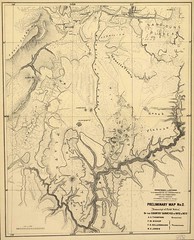I’ve been meaning to get this up. From a couple of weeks back. Trip to Bosque del Apache to see the birds. Cranes of course. And snow geese. Eagles. And the American coot, my current bird fascination. They’re so modest.
Daybook
- paper of the day: From GRL, Property loss potentials for European midlatitude storms in a changing climate: “In this study, loss potentials derived from an ensemble of climate models using a simple storm damage model under climate change conditions are shown. For the United Kingdom and Germany ensemble-mean storm-related losses are found to increase by up to 37%.”
- word of the day: larboard – the side of the ship from which you loaded those big giant shipping containers full of cheap shit from China
- book of the day: Lissa found the University of Michigan’s Digital Library Text Collection, which has John Wesley Powell’s original Smithsonian report on his first Colorado River expeditions.
- movie of the day: Nora and I went down to the Guild last night to watch We Aren’t Blocking Traffic, We Are Traffic, a documentary about San Francisco’s Critical Mass movement.
Climate Change: The Roswell Approach
Wish I’d thought of this:
OTTAWA (AFP) – A former Canadian defense minister is demanding governments worldwide disclose and use secret alien technologies obtained in alleged UFO crashes to stem climate change, a local paper said Wednesday.
“I would like to see what (alien) technology there might be that could eliminate the burning of fossil fuels within a generation … that could be a way to save our planet,” Paul Hellyer, 83, told the Ottawa Citizen.
Alien spacecrafts would have traveled vast distances to reach Earth, and so must be equipped with advanced propulsion systems or used exceptional fuels, he told the newspaper.
Such alien technologies could offer humanity alternatives to fossil fuels, he said, pointing to the enigmatic 1947 incident in Roswell, New Mexico — which has become a shrine for UFO believers — as an example of alien contact.
(Hat tip Nora)
More From the Federal Government’s Top Something-or-Another
Conrad Lautenbacher, head of the National Oceanic and Atmospheric Administration, has apparently been reading Roger Pielke Jr.:
The head of the nation’s weather and climate research agency says the biggest challenge facing the world is population growth and people’s desire to live in coastal areas where they can be endangered by storms.
“I believe that the population issue is huge,” Conrad Lautenbacher said Thursday. “And it’s not just the U.S., there are six billion … getting up to seven billion people on the Earth and they all want to live in coastal zones.”
La Niña
We’re standing on the brink of what ENSO forecasters call the spring barrier, the time of year when forecasting coming El Niño/La Niña conditions is hardest. But federal forecasters stuck their neck out today:
In a weekly update, scientists at the NOAA Climate Prediction Center noted that as the 2006-2007 El Niño faded, surface and subsurface ocean temperatures have rapidly decreased. Recently, cooler-than-normal water temperatures have developed at the surface in the east-central equatorial Pacific, indicating a possible transition to La Niña conditions.
What’s interesting here is not necessarily the details. Folks in the community have been talking about this lately. What’s interesting is the significance of the overt act of issuing a news release with the NOAA administrator’s name attached.
Are we having fun yet?
Zippy: No overcoats in February. What’s up with that?
Zerbina: Global warming. I’m lovin’ it!
Daybook
- reading: Em Hall’s High and Dry, a classic on New Mexico water that’s one of those books that everyone says you should read. I am.
- paper of the day: ENSO as a mediator of the solar influence on climate, Julien Emile-Geay and colleagues, in paleoceanography last month: “ENSO may plausibly have acted as a mediator between the Sun and the Earth’s climate.”
- maps: Western snowpack, from the University of Washington hydrology group. They’ve got a ton of useful products to help track conditions.
- phenology: My sister said Sunday she’s got her first daffodils (she’s also in Albuquerque)
- word of the day: loess – a wind-blown soil
China Drought
China’s state news agency is reporting drought on the Yangtze:
Falling water levels in China’s Yangtze River have left 1 million people short of drinking water, state media reported Monday. A severe drought has caused the water level in China’s longest river to plunge over the last two weeks, severely cutting water-pumping capacity, Xinhua News Agency said.
Shapingba Waterworks, one of the largest suppliers of drinking water to the industrial southwestern city of Chongqing, said only one of 10 pipes used to pump water from the Yangtze was in operation, Xinhua reported.
I don’t know much about China’s climatology, but a look at LDEO’s Standardized Precipitation Index page doesn’t look much like “severe drought” to me. Any of you climate geeks know a good source of China weather/climate data on relevant time scales?
Powell’s Grand Canyon Map
Our Map of the Week is a treasure from the Library of Congress: One of John Wesley Powell’s original Grand Canyon maps, made on completion of his survey work there in 1871-72. This is part of the Library’s amazing American Memory map collection.
Water and Energy
For a variety of reasons, I’ve been starting to pay attention of late to the water-energy nexus. Which is why this drew my eye:
According to news reports, Tampa is reviewing a request from Port Sutton EnviroFuels LCC for up to 500,000 gallons of freshwater per day to run Florida’s first Ethanol production plant. The facility today would be the city’s fifth-largest water customer, bigger than Tampa General Hospital, the University of South Florida or Busch Gardens. It is planned for the plant to transition to reclaimed water as the primary water source in the future.
Consumptive water use by ethanol plants largely comes from evaporation during cooling and wastewater discharge.


